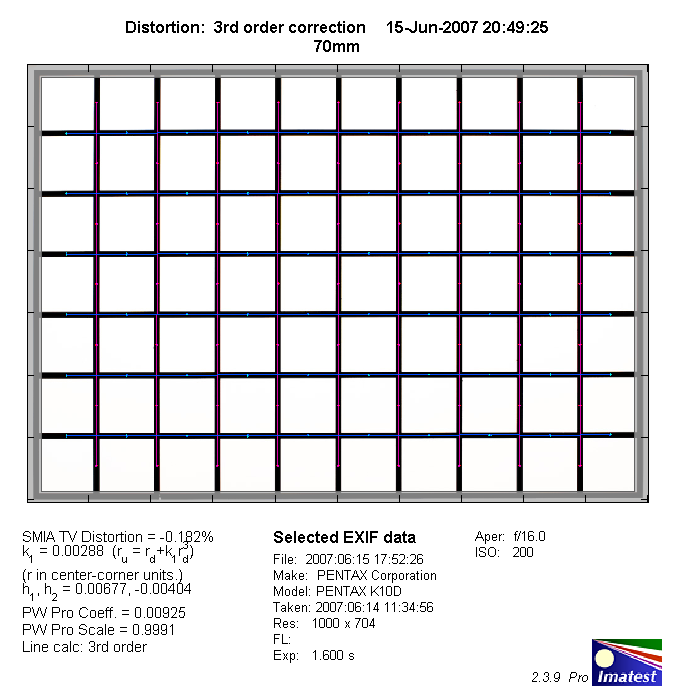|
Tamron AF 70-300mm f/4-5.6 LD Di macro (Pentax K) - Review / Lab Test Report - Analysis |
|
Lens Reviews -
Pentax
|
|
Page 2 of 2

Distortion
The Tamron exhibits a negligible degree of barrel distortion at 70mm changing to slight
pincushion distortion at 200mm and 300mm. This shouldn't be overly field relevant.
|
Move the mouse cursor over the focal length text marks below to observe the respective distortion
|
| 70mm |
200mm |
300mm |
|

|
The chart above has a real-world size of about 120x80cm.
Vignetting
Used on the K10D the (full format) Tamron shows only a slight degree of vignetting
at wide-open aperture (<0.5EV). This is usually nothing to worry about within the
APS-C scope.

MTF (resolution)
The resolution characteristic of the Tamron is not exceptionally high but generally
still decent. At 70mm and 200mm the center and border performance is on a very
good level straight from wide-open aperture down to f/11. At 300mm there's the
expected drop in quality. The center remains on a very good level whereas the borders
are somewhat soft at f/5.6. Stopping down lifts the border quality to quite respectable
levels. At 200mm and 300mm the contrast is a bit dull at large apertures - this
is typical for tele zoom lenses in this class.
Please note that the MTF results are not directly comparable across the different systems!
Below is a simplified summary of the formal findings. The chart shows line widths per picture height (LW/PH) which can be taken as a measure for sharpness.
If you want to know more about the MTF50 figures you may check out the corresponding Imatest Explanations
Chromatic Aberrations (CAs)
Lateral Chromatic aberrations (color shadows at harsh contrast transitions) are relatively
moderate at 70mm but quite pronounced at 200mm and 300mm.
Here's an example at 300mm f/8 (upper left and right border):
 

Verdict
Regarding its extremely low price tag you can't really expect a stellar performance
from the Tamron AF 70-300mm f/4-5.6 LD Di macro but from a value perspective
it is fairly amazing what it can give you. The resolution is very good till
200mm. At 300mm there's a drop in quality especially at f/5.6. Typical for such
lenses the contrast suffers at wide-open aperture so stopping down is advisable
from about 200mm onwards. Distortions and vignetting are not field relevant
whereas lateral CAs (color shadows at the image borders) can be fairly obvious at
longer focal lengths. Apart from the rotating front element the build quality of
the lens is actually pretty fine for a lens in this class (better than e.g. the
Canon EF 90-300mm f/4.5-5.6 or Nikkor AF 70-300mm f/4-5.6D ED).
| Optical Quality: |  |
| Mechanical Quality: |  |
| Price/Performance: |  |
|